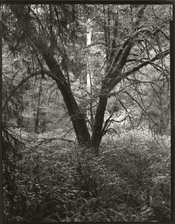runswithsizzers
Subscriber
We have all often heard the advice to "expose for the shadows" when shooting negative film. But I expect there may be some variation in the exact methods we use. Please include the following: Do you use box ISO or do you set your meter to some other EI? What kind of meter do you use? Where exactly do you aim the meter? After you take your meter reading, how do you set the camera?
My usual metering method is to take an incident reading following the instructions provided by Gossen or Sekonic - so I don't have much experience with metering for the shadows.
But if I wanted to meter for the shadows, I would do it something like this:
1. I usually set my meter to some EI slightly less than box speed: for most ISO 400 film from Kodak or Ilford, I would set my meter to EI 320 or 250. I usually develop in XTOL, which is said to be speed preserving.
2. I would choose something in my scene which I think should be in Zone 3 - say a shaded tree trunk that has some bark texture I want to preserve.
3. Using either my camera's built in meter (simple center weighted TTL), or one of my hand-held meters, I would take a reflected reading from the shaded tree trunk.
4. I would reduce the meter reading by two stops, and set the camera to that value.
I shoot 35mm film, so I don't mess with any kind of notes about contrast range or plus/minus developing - the whole roll unavoidably gets the same development.
It is Step 3 that I am particularly wondering about. I have heard some photographers would either take an incident reading in the shade - or take a reflected reading from a gray card in the same light (shade) as the zone 3 shadow. Pros and Cons?
My usual metering method is to take an incident reading following the instructions provided by Gossen or Sekonic - so I don't have much experience with metering for the shadows.
But if I wanted to meter for the shadows, I would do it something like this:
1. I usually set my meter to some EI slightly less than box speed: for most ISO 400 film from Kodak or Ilford, I would set my meter to EI 320 or 250. I usually develop in XTOL, which is said to be speed preserving.
2. I would choose something in my scene which I think should be in Zone 3 - say a shaded tree trunk that has some bark texture I want to preserve.
3. Using either my camera's built in meter (simple center weighted TTL), or one of my hand-held meters, I would take a reflected reading from the shaded tree trunk.
4. I would reduce the meter reading by two stops, and set the camera to that value.
I shoot 35mm film, so I don't mess with any kind of notes about contrast range or plus/minus developing - the whole roll unavoidably gets the same development.
It is Step 3 that I am particularly wondering about. I have heard some photographers would either take an incident reading in the shade - or take a reflected reading from a gray card in the same light (shade) as the zone 3 shadow. Pros and Cons?






